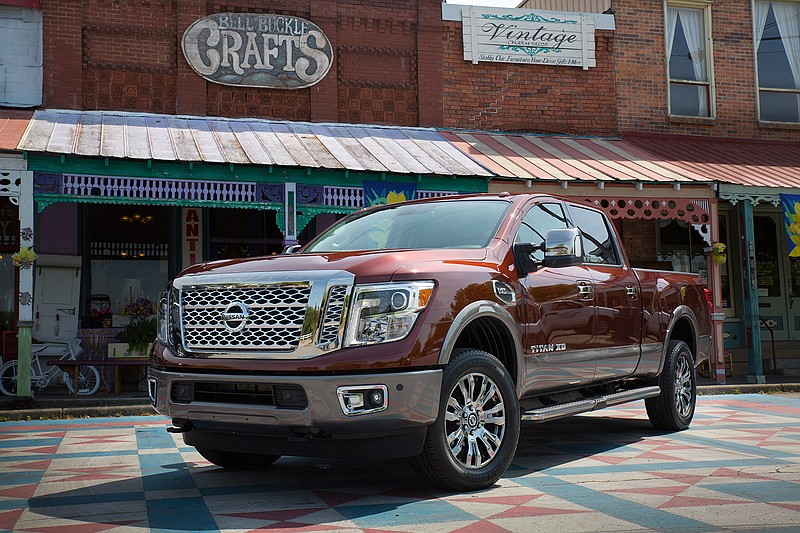It was 28 years ago that an American auto executive confidently told me, "The Japanese will never figure out how to build a full size, luxury automobile."
Wrong. As mllions of Lexus owners will attest, Japanese engineers and designers can, indeed, conceive and craft cars that soothe the senses and delight the driver.
It followed, then, that when Toyota and Nissan announced at the turn of the century that they would compete in the American auto industry's most sacred and prolific of cash cows, pickup trucks, Detroit trembled.
Wrong reaction again. Fifteen years later, the world yet awaits a Japanese built, full-size pickup that demonstrates kaizen, the excellence and reliability born of a devotion to continuous improvement, or kansei engineering, which incorporates a customer's emotional needs into product design.
Instead of trucks that delight and amaze, Nissan's Titan factory in Canton, Mississippi, and Toyota's Tundra plant in San Antonio continue to crank out trucks that stay at least two steps behind F-150, Silverado and Ram. The great ride, lush interiors and innovative engines and technology found in today's trucks all originated in Detroit. The Japanese seem content to play catch-up with good-not-great pickups.
It would be easy to suggest that this is because the brains and brawn behind the Japanese trucks are all American, but correlation ain't causation. The Toyota Highlander and Honda Ridgeline, leaders both, are just two examples of vehicles that were designed in American-based studios, blueprinted tested and built by American engineers and assembled by American workers.
By the way, I am only talking about full-size pickups. Toyota's Tacoma is dated, but its reputation for being bulletproof is one reason it is still the top-selling mid-size pickup. With the Ridgeline, chief engineer Kerry McClure took the same global architecture that Honda uses to build the Pilot and concocted the best driving, safest, most comfortable mid-size pickup on the planet.
Nor am I attempting to lump Titan and Tundra in the same basket. Toyota's pickup is outselling Nissan's four-to-one and has much better reliability ratings and resale values. If you're in the market for a used pickup, it's a smart play.
In truth, I have no verifiable theory to explain why Toyota and Nissan have failed to launch a game-changing pickup. One reason, I suspect, is that the trucks are not fully designed and built in-house. Scores of components are brought in from the same suppliers who build parts to Detroit's specs. The trucks are like a little brother or sister tagging along behind the Big Three, the same way American Motors used to build Ramblers from everybody else's parts bin.
The cause may not be clear, but the effect is. Through the first six months of 2017, for every Titan or Tundra sold in the U.S., eleven F-150s, Silverados, Sierras, or Rams went home with customers. In the world of pickups, brand loyalty runs deep, but as tens of thousands of people who used to build Cadillacs and Lincolns can attest, American consumers will change their minds when given good reason. Heck, they'll change spouses without one.
A wise man once told me that when one is going up an established company, being as good as the other guy won't do: You gotta be better. The failure of Toyota and Nissan to do that suggests their board rooms are satisfied with a small slice of the large and lucrative American truck pie.
Titan makes a move
Which finally brings us around to a review of this week's product, a Nissan Titan XD, billed as the Every-Duty Truck.
A couple of years ago Nissan lured Ram CEO Fred Diaz to revive its flagging truck division. He was the genius behind Ram's great-rides, eye-popping interiors and soaring market share. If Diaz is to work the same magic at Nissan, he's going to need some product, and Nissan had not done a significant refresh of its product line in more than a decade.
To design, test and bring to market a new vehicle can take up to five years and billions of dollars, but Diaz needed results sooner than that, so he started rummaging around in Nissan's parts bins. One thing he found was some terrific suspension components in the company's commercial vans, the NVs. Diaz, a savvy truck marketer, knew there was a soft spot in the market between light-duty pickups, like the F-150 and Silverado, and heavy-duty trucks, which are longer, wider, heavier and can haul things like four-horse trailers, small yachts and huge campers.
So Nissan modified and stretched its fully boxed ladder frame to a 151.6-inch wheelbase that can accommodate a standard crew-cab layout and a 6.5-foot bed. Add in the NV suspension components and, voila, a light-duty pickup with nearly the same ability as a half-ton pickup.
Thus was born the Titan XD.
Heads started to turn when Diaz went to his old friends at Cummins Diesel and wangled a supply of 5.0-Liter V-8 power plants, which make 310 hp and 555 lb-ft of torque. That's less than the heavy-duty diesels from Chevy, Ford and Ram, but considerably more than the work champ of the quarter-ton world, the Ram 1500 diesel V6 (240 hp and 420 lb-ft).
The Ram 1500 diesel's towing capacity tops out at 8,870 pounds, while typical 2500-series HD diesels can tow 14,000 to 17,000 pounds. That's a big gap, and the XD hits the sweet spot with a max towing capacity of 12,314 pounds.
So what you get with the XD is a pickup that measures nearly 20 feet from nose to tail, rides and handles like it's big, but not as cumbersome as an HD, and can outwork any gas-powered quarter-ton on the planet. It costs less and comes with the world's best truck warranty: 5 years, 100,000 miles.
Is the XD a good deal? One must read reams of spec pages to figure this out, but a well-equipped, regular cab, diesel-powered, 4WD Nissan runs around $43,070. Add niceties like running boards, spray-on bed liner, 20-inch wheels, rear monitors and parking sensors (which it really needs), a 110-volt outlet and Nissan's nifty track system for tying things down, and you're north of $45,000. A similarly equipped Super Duty F-250, for example, will sticker around $2,000 to $3,000 more, but for that, you get better more payload and a greater towing capacity.
The big Ford also gets better fuel economy. The EPA does not rate these things, but the last time we tooled a half-ton Ford around town we got around 18 mpg. We averaged a little better than 16 with the Titan XD.
You and I can sit down over a glass of ice tea and argue this value proposition all day, but it really would not matter. The XD gave Nissan something to show fleet buyers, and in that context, it makes tons of sense. When one is buying a thousand of something, a thousand dollars per unit equals a million bucks.
Diaz' strategy seems to be working. So far this year Nissan has sold nearly 25,000 Titans. To be sure, that is 1/16 of the number of trucks Ford has sold, but it's four times more than what Nissan sold in the first half of 2016.
Let's see, you quadrupled sales without retooling the factory? OK, you get to hang around.
Bottom line: Keep an eye on Nissan trucks the next few years. That game-changer may yet arrive.



